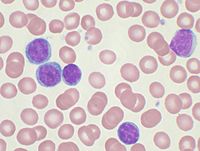
Photo from wikipedia
Opinion statementA number of new treatment options have recently emerged for chronic lymphocytic leukemia (CLL) patients, including the Bruton’s tyrosine kinase (BTK) inhibitor ibrutinib, phosphatidylinositol-3-kinase (PI3K) delta isoform inhibitor idelalisib… Click to show full abstract
Opinion statementA number of new treatment options have recently emerged for chronic lymphocytic leukemia (CLL) patients, including the Bruton’s tyrosine kinase (BTK) inhibitor ibrutinib, phosphatidylinositol-3-kinase (PI3K) delta isoform inhibitor idelalisib combined with rituximab, the Bcl-2 antagonist venetoclax, and the new anti-CD20 antibodies obinutuzumab and ofatumumab. Most of these agents are already included into treatment algorithms defined by international practice guidelines, but more clinical investigations are needed to answer still remaining questions. Ibrutinib was proven as a primary choice for patients with the TP53 gene deletion/mutation, who otherwise have no active treatment available. Idelalisib with rituximab is also an active therapy, but due to increased risk of serious infections, its use in first-line treatment is limited to patients for whom ibrutinib is not an option. A new indication for ibrutinib was recently approved for older patients with comorbidities, as an alternative to the already existing indication for chlorambucil with obinutuzumab. The use of kinase inhibitors is already well established in recurrent/refractory disease. Immunochemotherapy with fludarabine, cyclophosphamide, rituximab (FCR) remains a major first-line option for many CLL patients without the TP53 gene deletion/mutation, and who have no significant comorbidities or history of infections, and is particularly effective in patients with favorable features including mutated IGHV status. There are a number of issues regarding novel therapies for CLL that need further investigation such as optimum duration of treatment with kinase inhibitors, appropriate sequencing of novel agents, mechanisms of resistance to inhibitors and response to class switching after treatment failure, along with the potential role of combinations of targeted agents.
Journal Title: Current Treatment Options in Oncology
Year Published: 2017
Link to full text (if available)
Share on Social Media: Sign Up to like & get
recommendations!